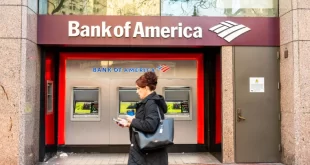To buy assets, cover working capital requirements, control cash flow, or grow the company, businesses require sizable capital reserves for seamless operations. Longer sales cycles or low cash reserves, however, may strain your finances. And you wind up trying to find another way to make money.
In this case, lease rental reduction gives you the chance to profit from the rents collected from your commercial property. A technique for obtaining a term loan with rental receipts as collateral is lease rental discounting. For small firms, it is a profitable way to meet their working capital needs or finance capital investments.
What is the Process of Lease Rental Discounting?
The financial institution, the tenant leasing the property, and the borrower who owns the property take this into account when calculating lease rental discounting. The monthly rent receipts that are taken from the lease by the owner serve as loan collateral. Additionally, the lender assesses the borrower’s long-term cash flow before authorizing an LRD-based loan for the agreed upon amount.
Put another way, the lender effectively “buys” the rent receivables from the borrower and, after subtracting the time value of money, authorizes a certain loan amount. The rents that are guaranteed, which the tenants deposit with the lender directly rather than through the borrower or lessor, are what will pay back the loan.
If you want to swiftly address the immediate financial needs of your company, lease rental reduction is a financially advantageous option you should investigate.
Characteristics of Lease Rental Discounting:
1. A Three-Party Agreement
With lease rental discounting, the projected rental cash flow serves as the loan’s security rather than the real estate. The lender consents to lend the borrower a reduced portion of the rent receivables. Additionally, when the tenant signs the rental agreement with the lender, they commit to paying them directly for the rent when the arrangement is in effect.
Because rent is paid directly to the lender as installments against loan repayment, this arrangement simplifies the loan application process.
2. Interest Rates that Are Competitive
When it comes to rented commercial or industrial premises, the lender typically offers lease rental discounts. Businesses can obtain reasonable loans at competitive interest rates because these sources yield quite high returns.

3. Using the Property for Two Purposes
Owners can make better use of their property via lease rental discounts. Company owners can increase their liquidity by taking out a loan against their property and using the rental cash flow as leverage to get another loan.
4. Harmonious Monetary Flow
To offset the increased loan amount, the majority of lenders provide longer loan terms. The business owner is relieved of the burden of loan repayment as the loan is repaid through EMIs based on monthly rental income. This guarantees that the company’s cash flow is balanced.
Why is Discounting for Lease Rentals Done?
The money can be utilized for any worthwhile endeavor because the loan from LRD is multifunctional.
Company Growth
If the lessor wants to invest in new properties while minimizing their own expenses, a long against rent receivables is a great choice. Owners of real estate can utilize the money to expand any form of business. They may now satisfy their business needs without having to strain their money, which is an advantage.
Loan Repayment
It is simple for property owners to use these money as leverage to refinance or pay down current debt. Lease rental discounting becomes a cost-effective option for quickly repaying high-interest loans due to its prolonged repayment period and appealing interest rates.
Invest in New Real Estate
A financially appealing choice for borrowers whose main source of income is rental income is lease rental discounting. Thus, the lessor can use these monies to buy a new home, expanding their portfolio and bringing in more rental income.
Furthermore, since the lessor does not have to pay the EMIs out of pocket with an LRD-based loan, the existing property serves as a source of loan repayment. This is a clever strategy for growing a rental company.
Conditions necessary for leasing rental discounting
1. Business Renters
Lease rental discounting is only useful in situations where the cash flow is certain, since lenders use the projected future cash flow to approve a loan today. Lenders will therefore sanction a loan against rent receivables in cases where the tenants have sufficient income to cover their rent obligations.
2. Extended Lease Duration
Lessors that have a property with a longer lease tenure can benefit from lease rental lowering. Lenders do not provide short-term lease rental discounts since long-term debt (LRD) is a high-financing option with a longer repayment period.
Let Me Turn it to You.
Lease rental discounting is a useful tool for businesses to meet any financial requirements and helps you maximize your rental income. Speak with Tata Capital professionals for additional advice on loan terms, interest rates, and other topics!
LRD: What is it? LRD Meaning, Eligibility, Full Form, and More:
LRD, or lease rental discounting, is a type of loan secured by a property’s rent receivables. By giving them money in return for their rent receivables, it enables landlords and renters to realize the full financial potential of their asset or lease.
The monthly rental revenue from the property and the borrower’s ability to repay the loan determine the amount of the LRD loan. LRD loans are a desirable financing choice since they allow borrowers to receive a larger loan amount than they would with a standard loan.
LRD loans can be used for a number of things, including financing college education, property renovation, and business expansion.
Examining the Distinctions Between Indian LRD Loans and Conventional Loans
LRD loans, also known as Lease Rental Discounting loans, are a particular kind of loan intended for owners of real estate who get rental income from their holdings.
Conventional loans in India are normally granted on the basis of the borrower’s income, collateral, and creditworthiness. On the other hand, LRD loans are mainly provided in accordance with the rental revenue that the property produces. The rental income and property valuation are used to determine the loan amount.
LRD loans have payback terms that are arranged differently from conventional loans. Lease rental discounting loans are normally repaid over extended periods of time—up to 15 years—using the rental revenue that the property generates.
The qualifying requirements are another important distinction between LRD loans and conventional loans in India. The main target audience for LRD loans is owners of commercial real estate that brings in rental revenue. On the other hand, traditional loans in India are available to people for a range of uses, including commercial, personal, and housing loans.

Comparing Rent Deposit Loans vs LRD Loans: Highlighting the Main Distinctions
Owners of rental properties can choose between two forms of financing: rent deposit loans and LRD (Lease Rental Discounting) loans. However, there are some significant differences between the two.
LRD loans are determined by the amount of rental revenue a property brings in. After examining the rental income, the lender will make a loan offer based on a portion of that income. The rental income often serves as the security for the loan amount and determines the terms of repayment.
On the other hand, rent deposit loans are obtained using the security deposit that the renter has paid. The terms of repayment are often based on the tenant’s lease agreement, and the loan amount is typically restricted to a portion of the security deposit.
Unlocking Rental Income’s Potential: Using Rent Receivables to Secure LRD Loans
One of the main benefits of LRD loans is the ability to leverage rent receivables. The property’s rental revenue may be used as security to get a loan. LRD loans are therefore available without the need for any extra collateral. For property owners who might not have any other assets to pledge as collateral for loans, this is advantageous.
Furthermore, while securing financing, rent receivables enable property owners to hold onto their real estate. They are able to expand their business and continue to make rental money as a result.
How Small Businesses Can Benefit from Lease Rental Discounting Loans
Capital is needed by small firms to develop and broaden their activities. LRD loans provide a different kind of funding than conventional bank loans. Small business owners can use the money to grow their company, hire more employees, or buy new equipment.
Small business owners can secure finance without jeopardizing their own assets by using LRD loans to leverage their rental property.


